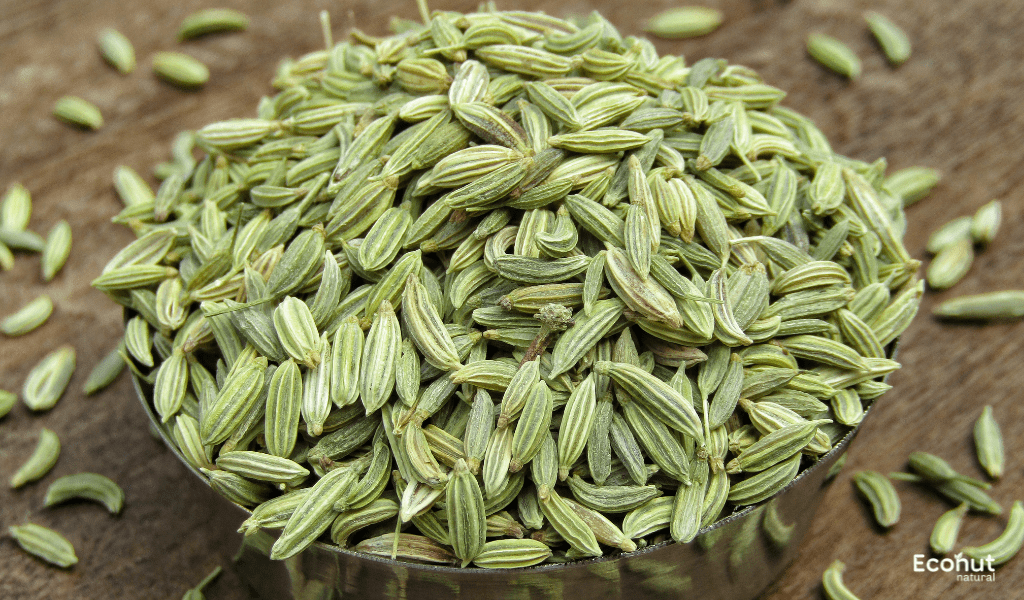Mishreya, sometimes referred to as Indian sweet fennel, is scientifically known as (Foeniculum Vulgare). Fennel seeds are typically used to flavor soups, sauces, meat dishes, some pickles, and sweets. Every nation in the world includes Mishreya in their pharmacopoeia.
This herb works wonders for relieving gastrointestinal spasms and calming stomach muscles. It is regarded as an efficient herbal medicine for treating gas and bloating as a result. It also relieves upset stomachs, which helps to ease cramping in the abdomen, and reduces constipation. Tea made from fennel is recommended for those with chronic irritable bowel syndrome.
Description
The tall, green, erect, hollow stem of fennel, a perennial herb, can reach a height of 2.5 cm. The leaves are thinly sliced into structures that resemble threads and measure roughly 40 cm in length and 0.5 mm in width. Umbels, which are formed in bunches of flowers, measure between 5 and 15 cm in width. There are 30–50 small, yellow-colored flowers on short peduncles in each umbel. When fennel seeds reach maturity, their green hue changes to a light brown hue, giving them a fragrant appearance
Botanical Name:
Foeniculum Vulgare
Family:
Apiaceae
Leaves:
It is a perennial herb with soft, feathery leaves that resemble hair. This plant is smooth, cylindrical, erect, and has several branching leaves. The lacy leaves have enlarged petioles that cling to the stalk to form an eatable structure. The leaves can grow up to 40 cm in length and 0.5 mm in width.
Flowers:
Fennel bears tiny yellow flowers in summertime bunches at the top of its stems. Although not very spectacular, these blossoms add to the plant’s overall attractiveness.
Fruits:
Fennel “seeds” are actually fruits known as schizocarps. When fully ripe, these fruits spontaneously split into two half, each holding one seed.
Stems:
The smooth, hollow stem of fennel is either green or somewhat purple in color. It is an upright growing plant that can grow to be 3–8 feet tall.
Seeds:
The fennel plant’s seeds are the portion that is most frequently utilized. These have an oval form, measure ¼ inch (0.6 cm) in length, and are either yellowish-brown or greenish-grey in hue. They have one flat side and vertical ridges. The intense, licorice-like flavor and scent of fennel are derived from the seeds.
Habitat:
Mishreya hails from the Mediterranean area, encompassing Europe, North Africa, and Western Asia. They live in Hawaii, Australia, Fiji, Queensland, Austria, and a sizable chunk of Central and North America.
Parts Used:
- Roots
- Stems
- Leaves
- Fruits
- Fruit oil
Dosage:
- 500 mg to 2 gm
Synonyms
Shaleen, Madhurika, Missi, Badi sauf, Panamadhuri, Badi sopu, Sabbsige, Mouri, Panmori, Sompu, Badi sepu, Perumjikam, Kattusatkuppa, Madesi saunf, Bitter fennel, Common fennel, Indian sweet fennel,Foeniculum vulgare Miller., Ejiyanaj, Aslul ejiyanaj, Razianaj, Rajyana, Chatra, Saunf, Mishreya,Variyaali, Valiaari, Pedhyajilkurra, Sohikire, Shoumbu.
Chemical Constituents
The primary component of mishreya, anethole, is one among the plant’s numerous significant active chemical ingredients. Beta-myrcene, safrole, bitter fenchone, alpha pinene, limonene, estragiole, p-cymen, and camphene are other components. Beta-carotene, calcium, iron, vitamin C, and metal cations are abundant in Mishreya.
Other Language Names of Mishreya (Foeniculum Vulgare)
Sanskrit name – Mishreya, Madhurika
Tamil name – Perun siragum, shombu, sohikire
Telugu name – Peddajilakurra, sopu
Uttarakhand name – Badesoppu
Slovenian name – Sladki komarcek
Somali name – Ethiopia Kamon
Hindi name – saunf, Badi, badishep, bari saunf, badi, sonp, sont
English name – Bitter fennel, common fennel, sweet fennel, wild fennel
Gujarati name – Hariyal, variyali
Haryana name – Saunf
Jammu and Kashmir name – Saunf
Marathi name – Badishep, shoap
South Europe name – Fennel
South Africa name – Vinkel, fennel
Spanish name – Hinojo, hinojo amargo, fenoll, fiollo, millua
Swedish name – Fank
Nepalese name – Madesi, sauf
Pakistan name – Sonef, saunf
Peninsula, Spain name – Hinojo
Italy name – Finucchio, finucchiello,
North Iran name – Badian
North Portugal name – Funcho
Jordan name – Shomar
Kallawaya name – Jinuchchu
Kannada name – Badi sopu, dodda sopu, badisepu, sabbasige, dodda jirige
Korea name – Sohoehyang
Norway name – Fenikkel
Norwegian name – Fennikel
Japanese name – Fenneru, uikyou, uikyou, shouikya
Indonesia name – Adas
Scientific Classification
| Kingdom | Plantae |
| Subkingdom | Tracheobionta |
| Superdivision | Spermatophyta |
| Division | Magnoliophyta |
| Class | Magnoliopsida |
| Subclass | Rosidae |
| Order | Apiales |
| Family | Apiaceae |
| Genus | Foeniculum |
Ayurvedic Properties
Hindi/Sanskrit
- Rasa -Madhura, Katu, Tikta
- Guna -Laghu, Snigdha
- Virya -Ushna
- Vipaka -Madhura
English
- Taste -Sweet, Pungent, Bitter
- Physical Property-Light, Unctuous
- Potency- Hot
- Metabolic Property (After Digestion)-Sweet
Mishreya (Foeniculum Vulgare) Uses
- Seeds can be used to treat conditions of the mouth and dry cough.
- This herb’s roots have a carminative quality.
- Because of their fragrant qualities, leaves are used to promote perspiration and increase urine volume.
- Constipation and distention of the abdomen can be relieved by administering a pure extract enema.
- Powdered seeds are excellent for eliminating contaminants from urine and for treating uncomfortable micturition.
Mishreya (Foeniculum Vulgare) Benefits
Aids Digestion:
Digestion is accelerated by the components of essential oils found in fennel, which cause the secretion of digestive fluids and enzymes. Fennal lessens abdominal bloating brought on by flatulence, or excessive gas production. Fennel minimizes gastric and intestinal inflammation and promotes optimal nutritional absorption from broken down meals.
Boosts Immune System:
Vitamin C, an important antioxidant that helps builds collagen for healthy skin and tissues ward off dangerous free radicals, and bolster the immune system is abundant in fennel seeds. Fennel seeds strengthen and support our immune systems.
Pain relief:
Fennel is also thought to be beneficial for reducing pain. According to the same Bangladeshi study, fennel extracts decreased pain signals to a degree that was comparable to aspirin’s.
Regulate Blood Pressure:
Potassium is abundant in fennel seeds, which contributes to blood fluid equilibrium. This regulates your blood pressure and heart rate. According to studies, nitrite, a naturally occurring substance that controls blood pressure, is more abundant in saliva when fennel seeds are present. Fennel seeds contain potassium, which helps regulate the water content and counteract the negative effects of sodium.
Mishreya (Foeniculum Vulgare) Side Effects
Stomach upset:
Some people may have stomach distress from fennel, including bloating, gas, and diarrhea.
Sun sensitivity:
Fennel may make your skin more photosensitive. When eating fennel, make sure you wear protective clothes and sunscreen when you go outside.
Allergic reactions:
Fennel allergies can cause skin rashes, itching, or swelling in certain people.
Don’t miss: Ela, Cardamom (Elettaria cardamomum) – Benefits, Uses & Side Effects
Conclusion
Fennel seeds have several health benefits and can be consumed on their own, in cuisine, or steeped to make a soothing tea. Because of this, they are an essential component of a healthy, balanced diet. Keep in mind that each person has unique nutritional requirements, so it’s always preferable to see a doctor or certified dietitian for personalized advice on incorporating fennel or any other food in your diet.
FAQS
What is the Ayurvedic use of Foeniculum vulgare?
Fennel is considered to be very beneficial for digestion in Ayurveda. It tones the digestive tract overall and is especially useful for strengthening agni, the digestive fire, without making Pitta more agitated.
What is the botanical name of Mishreya?
Foeniculum Vulgare
What is the family of Foeniculum vulgare?
Apiaceae

